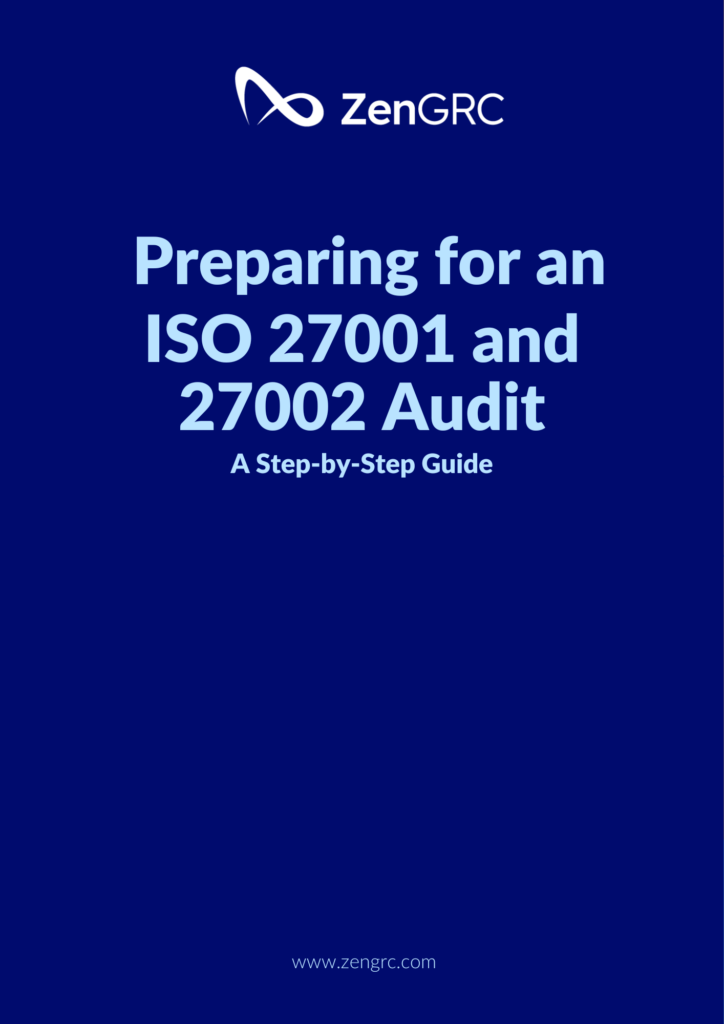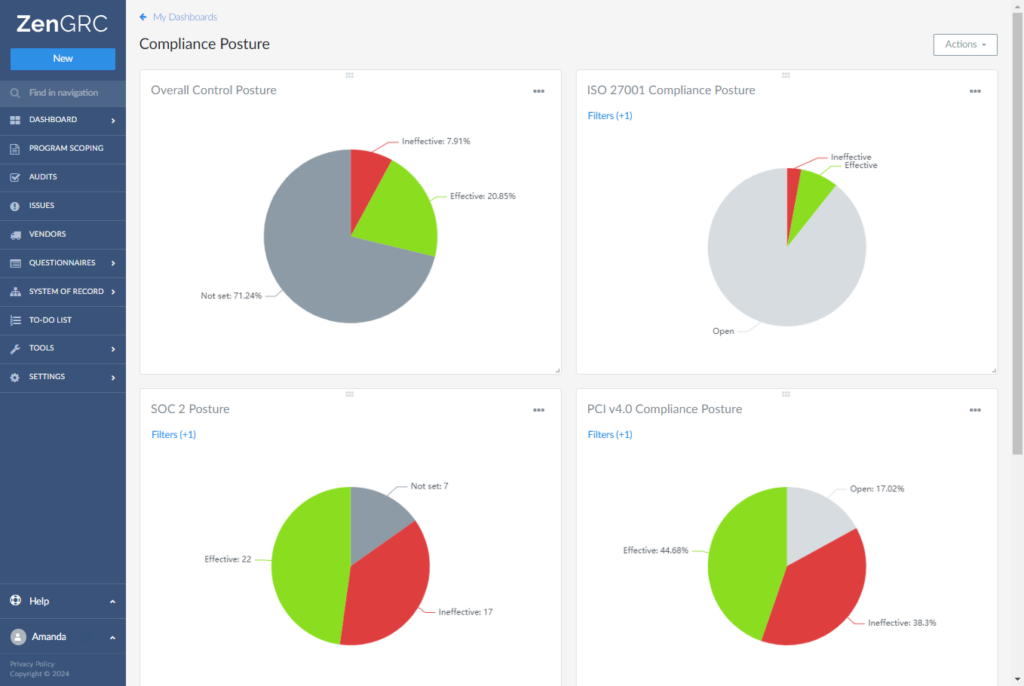ISO Compliance Management Software
Discover ZenGRC: The Key to ISO Compliance Success
ZenGRC is a cloud-based software solution designed to simplify and streamline the achievement of compliance with various ISO standards, including 27001, 27002, 27701, 27017, 27018, 42001.
ZenGRC’s intuitive interface and comprehensive suite of tools assists organizations in managing and maintaining compliance with various ISO standards. Achieving ISO compliance can simplify audit management and improve customer satisfaction. The quality management system (QMS) platform offers a centralized system for tracking, reporting, and assuring that all compliance requirements are met, making it indispensable for businesses aiming to succeed in ISO compliance endeavors.
Achieve ISO Compliance Certification Easily with ZenGRC
ZenGRC offers a user-friendly platform that simplifies the ISO compliance certification process for all organizations. It provides guided assistance from gap analysis to final certification, ensuring a structured and stress-free compliance journey.
Automation to Streamline ISO Compliance Workflows
ZenGRC introduces automation to ISO management, streamlining workflows and reducing manual effort. Automated reminders and task tracking increase efficiency and accuracy, allowing teams to focus on strategic aspects like risk assessment and continuous improvement.
Documentation Management for ISO Audits
ZenGRC features robust documentation management tailored for ISO audits, ensuring secure storage, easy retrieval, and organization of compliance-related documents, thereby facilitating a smoother audit process.
Monitoring the Entire ISO Compliance Lifecycle
ZenGRC’s centralized management system enables continuous monitoring of the ISO compliance lifecycle, providing real-time visibility and insights into compliance status, risks, and audit readiness.
ISO Insights and Monitoring
ZenGRC offers advanced analytics and reporting tools for in-depth ISO compliance monitoring. These insights help organizations analyze compliance performance, identify trends, and make data-driven decisions for continuous improvement.
ISO Compliance Audit Checklist
- Plan, implement, and maintain a compliance audit program
You will first need to establish a team responsible for planning, implementing, and monitoring your audit management and compliance management program overall. This team will perform a risk assessment, take any corrective action to mitigate risks, and implement a management process for monitoring and maintaining compliance. - Define the criteria and scope of your ISO audit Your organization is not only responsible for creating and maintaining a compliance program, but it must also understand the scope of any ISO audit for which you’re preparing to ensure that all requirements have been met. Ignoring audit requirements can result in costly re-certification.
- Conduct an internal audit first to ensure all requirements have been met To ensure that you can be confident about the results of a formal audit, it’s a good idea to conduct an internal audit before that formal one. An internal audit will allow you to gather valuable data around your ISO compliance and indicate any areas that still require remediation. Furthermore, your organization should conduct routine internal audits to achieve continuous improvement over time.
- Take corrective action for any vulnerabilities uncovered during auditing Whether that corrective action is a system that requires calibration, sensitive document controls that need to be implemented or business processes that must be adapted to incorporate stronger security controls — it’s important to remediate all potential indicators that your organization may not pass certification.
- Document all risk management, controls and remediation efforts Compliance certifications depend heavily on documentation of management systems and the controls that are implemented within them. Therefore, any steps you take to assess vulnerabilities, facilitate risk management, or implement security and quality standards should be documented and saved for your compliance audit.
ZenGRC Success Stories
Achieving ISO 27001 and 27002 Certification with ZenGRC
Explore how ZenGRC facilitated a swift and successful ISO 27001 and 27002 certification journey for an international financial organization. With its user-friendly, cloud-based system, the platform significantly simplified audit processes and streamlined governance, risk, and compliance (GRC) operations, leading to an efficient and error-free path to certification in just six months.

Types of ISO Compliance Standards
The following are several examples of the most common ISO standards that ZenGRC can support:
ISO 27001/2: Guidelines for how to manage information security management systems
ISO 27701: Extension to ISO 27001/2 for privacy information management – requirements and guidelines
ISO 27017: Code of practice for information security controls based on ISO 27002 for cloud services
ISO 27018: Code of practice for protection of personally identifiable information (PII) in public clouds acting as PII processors
ISO/IEC 42001 – Information Technology Artificial Intelligence Management System: Provides requirements for establishing, implementing, maintaining, and continuously improving an AI management system. A voluntary framework that organizations can certify to demonstrate responsible AI development. Learn more here.
ISO Compliance Made Easy with ZenGRC
Pre-Built Templates, Automated Audits, and Real-Time Monitoring to Ensure Compliance with ISO
Achieving compliance certification for any ISO standard or standards requires considerable time and financial resources, particularly for organizations still using legacy tools and spreadsheets to achieve and maintain compliance workflows.
Also, remember: initial compliance certification is only half the battle. After certification, your organization must maintain compliance management to ensure that the new systems, processes, and controls don’t degrade over time and are updated as your organization grows and your risks change.
This is far too great a responsibility for a large organization to achieve manually. Instead, adopting a compliance tool will automate your enterprise’s ISO compliance and certification. That will save you time, money, and a lot of headaches.
At ZenGRC, we can help you prepare your ISO compliance and certification program, expedite the process, and minimize the burden on your team.
ZenGRC ISO Capabilities
Our fully integrated and automated solutions equip you with a strong foundation for ISO compliance, enabling you to monitor your program over time to ensure you remain compliant and avoid non-compliance penalties. Our capabilities include:
- Automation to streamline compliance workflows
- Monitoring of the entire compliance lifecycle
- User-friendly dashboard with real-time metrics on prioritized ISO audit tasks
- Pre-built evidence request templates to help you prepare for auditing
- A central document management repository to organize audit-ready documentation
- Universal control mapping functionality to fulfill multiple requirements with a single control
- Tracking of outstanding ISO tasks
- Complete Risk Management functionality for assessments, scoring, and treatment throughout the risk lifecycle
- Interconnectivity between threats, vulnerabilities, risks, and controls for greater insight and monitoring

FAQs for ISO Compliance
Who needs ISO certification?
Your need for ISO certification depends on your industry and its compliance requirements. However, industries required to meet ISO compliance standards include engineering, manufacturing, healthcare, IT, construction, etc.
Is ISO compliance a mandatory legal requirement?
ISO certification is usually not legally required for most industries. Instead, specific sectors have strong business incentives to embrace ISO standards as a demonstration of an organization’s commitment to high quality and performance standards.
ISO Compliance vs. ISO Certification: What’s the difference?
The difference between ISO compliance and ISO certification comes down to audits. ISO certification requires an external audit by an independent professional accredited by the Committee on Conformity Assessment (CASCO). Mere ISO compliance can be without this audit.
Both ISO compliance and ISO certification are voluntary; they aren’t regulations. Instead, they are recommendations. That said, some organizations, such as manufacturers, may require their third-party suppliers to be ISO-certified to assure the quality of their goods, services, and processes and the security of their information, systems, and networks.
The benefits of certification include international recognition and the ability to do business in many industries.
Some organizations – particularly smaller ones with smaller budgets – may opt out of the cost and preparation time needed to pass the audit required for certification. They may decide that compliance is good enough and forego the added expense of certification.
What features should I look for in ISO compliance software?
Key features to look for in ISO compliance management software include:
- Centralized policy, document, and case study repository
- Workflow automation for processes like risk assessments and incident management
- Dashboards to view compliance status and tasks
- Audit trail recording for evidence of compliance
- Reporting tools to demonstrate compliance
- Integrations with existing systems
- Collaborative features like role-based access, notifications, and workflow approvals
The proper Governance, Risk, and Compliance (GRC) software streamlines and automates compliance activities, saving considerable time and effort.
What are the benefits of ISO certification?
There are several advantages to obtaining ISO certification:
- Increased customer and stakeholder trust and confidence
- Recognition for meeting international quality, environment, and information security standards
- More efficient internal processes and reduced risks
- Competitive edge over non-certified companies
- Access to new business opportunities
While demanding, certification can pay dividends through increased sales, cost reductions, improved safety, and risk mitigation.
